Hello together,
as you may know, I am writing a game "Hammurabi", which shall be connected to Hive someday.
This post bases on Implementation of Swagger.io und Postman to Springboot.
Here I want to show what I did, to enhance the functionality of the Webserver. Until now it only supports get requests (read).
I also want to be able to Create, (Read), Update and Delete (CRUD) my data-set.
Create
To enable create, in the controller we need to refer to the repository-Interface. For this we create the new propertiy "userlogrepository" from the type UserlogRepository and make it public to Spring by marking it with "@Autowired":
@Autowired
UserlogRepository userlogrepository;
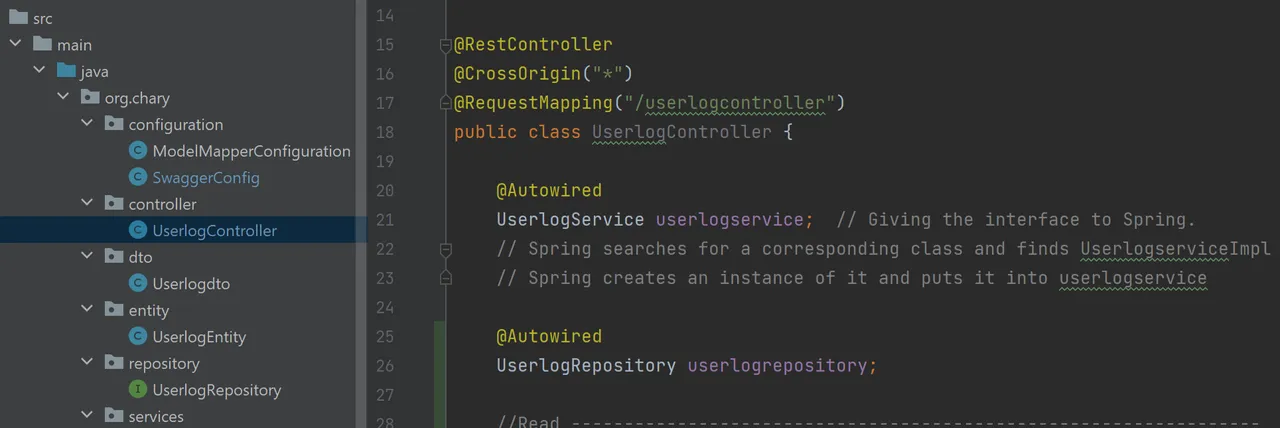
The second thing we need to do is to add the @Postmapping method, which creates a new userlog-Entry:
//Create -----------------------------------------------------------------
@PostMapping(value = "/userlogs")
public UserlogEntity newUserlog (@RequestBody UserlogEntity newUserlog)
{
return userlogrepository.save(newUserlog);
}
Here is the complete UserlogController file (so far):
package org.chary.controller;
import org.chary.dto.Userlogdto;
import org.chary.entity.UserlogEntity;
import org.chary.repository.UserlogRepository;
import org.chary.services.UserlogService;
import org.springframework.beans.factory.annotation.Autowired;
import org.springframework.http.MediaType;
import org.springframework.web.bind.annotation.*;
import java.awt.*;
import java.util.ArrayList;
import java.util.List;
@RestController
@CrossOrigin("*")
@RequestMapping("/userlogcontroller")
public class UserlogController {
@Autowired
UserlogService userlogservice; // Giving the interface to Spring.
// Spring searches for a corresponding class and finds UserlogserviceImpl
// Spring creates an instance of it and puts it into userlogservice
@Autowired
UserlogRepository userlogrepository;
//Read -----------------------------------------------------------------
@GetMapping(value = "/userlogs") //curl -X -get http://localhost:8099/userlogcontroller/userlogs"
public List<Userlogdto> getAllUserlogs() {
System.out.println("Hier sind alle Userlog-Einträge: " + userlogservice.getAllUserlogs().toString());
return userlogservice.getAllUserlogs();
}
@GetMapping(value = "/welcome")
public String welcome() {
return "Welcome to the Hamurabi-Game - Written by Achim Mertens";
}
//Create -----------------------------------------------------------------
@PostMapping(value = "/userlogs")
public UserlogEntity newUserlog (@RequestBody UserlogEntity newUserlog)
{
return userlogrepository.save(newUserlog);
}
}
Now we can send data via curl:
C:\Users\User>curl -v -X POST http://localhost:8099/userlogcontroller/userlogs -H "Content-Type:application/json" -d "{\"id\":\"6\",\"username\":\"AxelSchweiss\",\"logintime\":\"2022-02-02 12:16\"}"
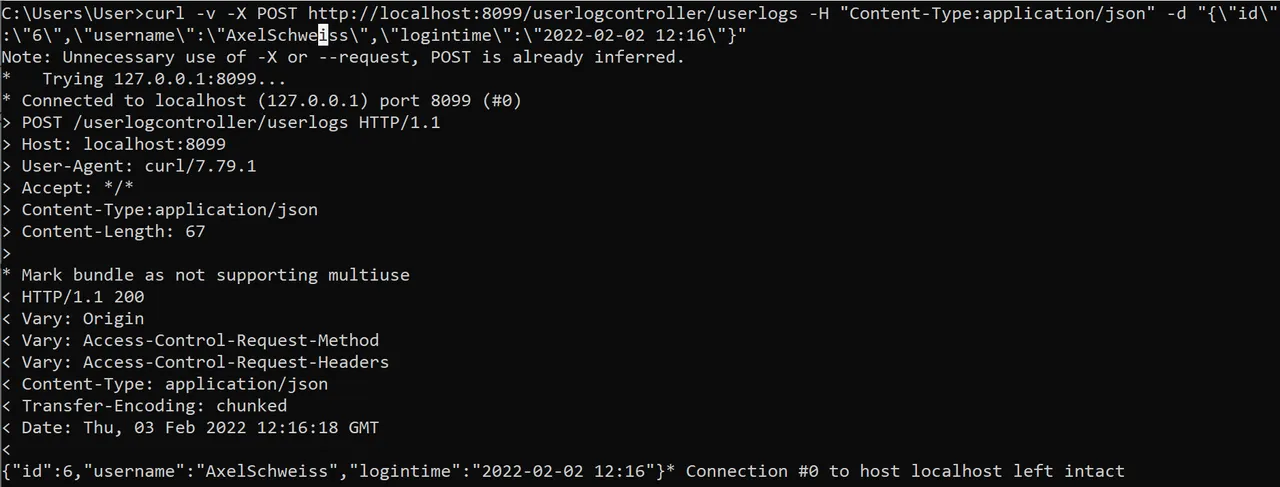
Or we can do it via Postman:
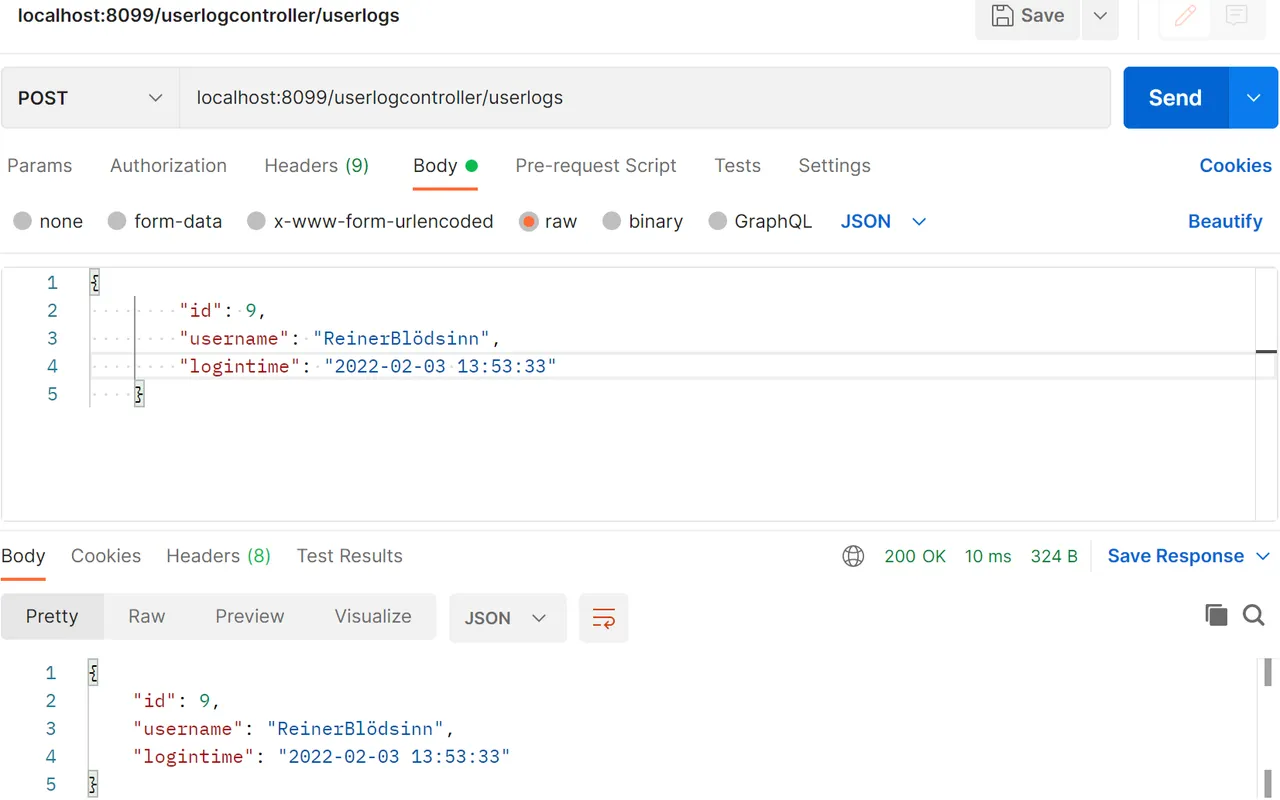
Read single value
Now I want to add the possibility to get only one data set.
I have added the following part into the controller:
// Read Single Item
@GetMapping(value = "/userlog/{id}")
public Optional<UserlogEntity> one (@PathVariable String id)
{
return userlogrepository.findById(id);
}
(I also changed the Type of the id from Integer to String.
(Which caused the error: Unknown integral data type for ids : java.lang.String. I had to comment out @GeneratedValue in the UserlogEntity class:
@Id
//@GeneratedValue is only allowed if ID is from type integer
))
To read the first dataset insert into the command line:
curl -v -X GET http://localhost:8099/userlogcontroller/userlog/1 -H "Content-Type:application/json"

Update
To get the feature, that the data can be updated, we add the following into UserController class:
//Update ----------------------------------------------------------------
//The object "userlogEntity" is automatecally created by Spring, so we don't need an instantiation here anywhere
//The result of "userlogEntity" is copied into "userlogEntity"
@PutMapping("/userlogs/{id}")
public UserlogEntity replaceUserlog(@RequestBody UserlogEntity replaceUserlog, @PathVariable String id) {
return userlogrepository.findById(id).map(userlogEntity -> {
userlogEntity.setUsername(replaceUserlog.getUsername());
userlogEntity.setLogintime(replaceUserlog.getLogintime());
return userlogrepository.save(userlogEntity); })
.orElseGet( () -> {
replaceUserlog.setId(id);
return userlogrepository.save(replaceUserlog);
});
}
After restarting the server, we are able to update some data, here the logindate of the dataset from ID=4:
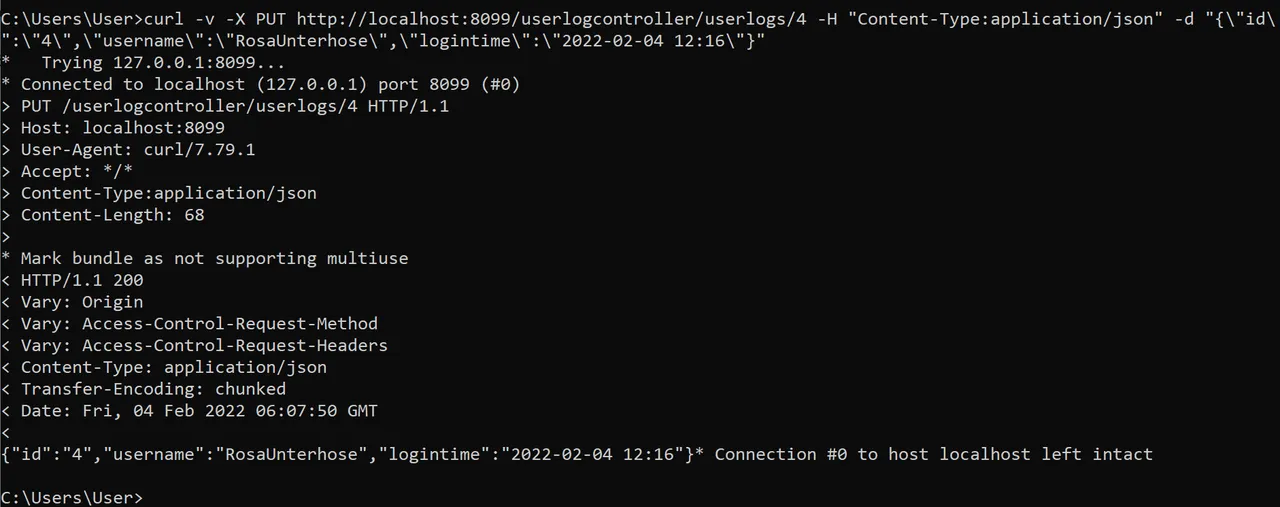
And here we change a complete dataset (with ID=2) via postman:

Delete
We add the following to the controllerclass:
/**
* //Delete --------------------------------------------------------------------
* curl -v -X GET http://localhost:8099/userlogcontroller/userlog/17 -H "Content-Type:application/json"
**/
@DeleteMapping("userlog/{id}")
void delteUserlog(@PathVariable String id) {
if (userlogrepository.findById(id).isPresent()) {
userlogrepository.deleteById(id);
}
}
After rebooting we can delete a user:
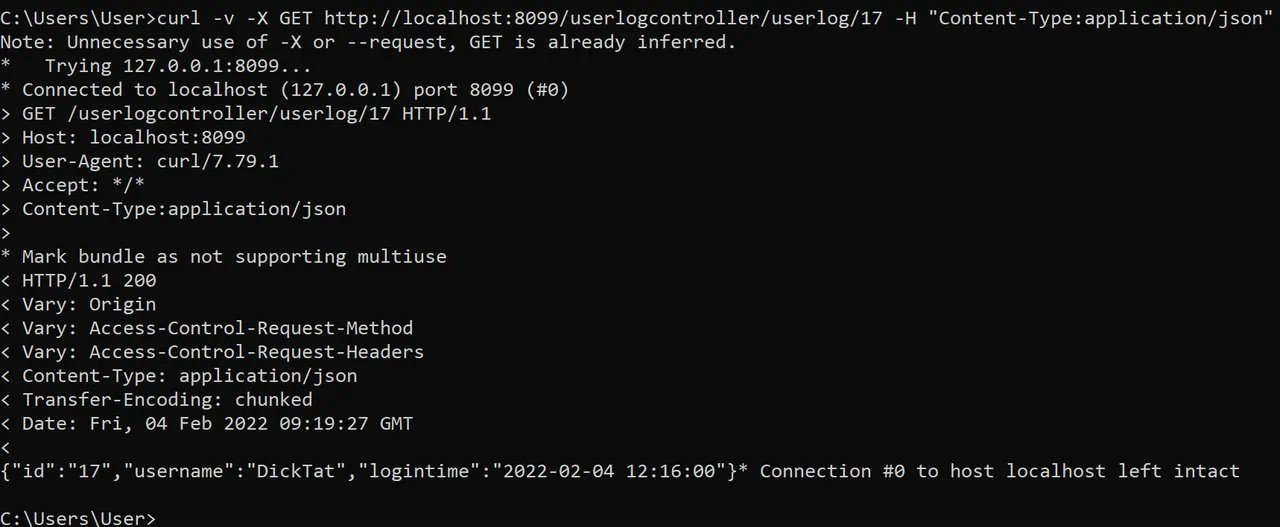
Same with Postman:

At the end, our userlogcontroller looks like this:
package org.chary.controller;
import org.chary.dto.Userlogdto;
import org.chary.entity.UserlogEntity;
import org.chary.repository.UserlogRepository;
import org.chary.services.UserlogService;
import org.springframework.beans.factory.annotation.Autowired;
import org.springframework.web.bind.annotation.*;
import java.util.List;
import java.util.Optional;
@RestController
@CrossOrigin("*")
@RequestMapping("/userlogcontroller")
public class UserlogController {
@Autowired
UserlogService userlogservice; // Giving the interface to Spring.
// Spring searches for a corresponding class and finds UserlogserviceImpl
// Spring creates an instance of it and puts it into userlogservice
@Autowired
UserlogRepository userlogrepository;
/**
* //Read -----------------------------------------------------------------
* //curl -X -get http://localhost:8099/userlogcontroller/userlogs"
**/
@GetMapping(value = "/userlogs")
public List<Userlogdto> getAllUserlogs() {
System.out.println("Hier sind alle Userlog-Einträge: " + userlogservice.getAllUserlogs().toString());
return userlogservice.getAllUserlogs();
}
/**
* // Read Single Item
* curl -v -X GET http://localhost:8099/userlogcontroller/userlog/17 -H "Content-Type:application/json"
**/
@GetMapping(value = "/userlog/{id}")
public Optional<UserlogEntity> one(@PathVariable String id) {
return userlogrepository.findById(id);
}
@GetMapping(value = "/welcome")
public String welcome() {
return "Welcome to the Hamurabi-Game - Written by Achim Mertens";
}
/**
* //Create -----------------------------------------------------------------
* // curl -v -X POST http://localhost:8099/userlogcontroller/userlogs -H "Content-Type:application/json" -d "{\"id\":\"17\",\"username\":\"DickTat\",\"logintime\":\"2022-02-04 12:16\"}"
*/
@PostMapping(value = "/userlogs")
public UserlogEntity newUserlog(@RequestBody UserlogEntity newUserlog) {
return userlogrepository.save(newUserlog);
}
/**
* //Update ----------------------------------------------------------------
* The object "userlogEntity" is automatecally created by Spring, so we don't need an instantiation here anywhere
* The result of "userlogEntity" is copied into "userlogEntity"
* Example:
* curl --location --request PUT 'localhost:8099/userlogcontroller/userlogs/2' \
* --header 'Content-Type: application/json' \
* --data-raw ' {"id": "2","username": "AtzeTon","logintime": "2022-01-31 14:16:00"}'
*/
@PutMapping("/userlogs/{id}")
public UserlogEntity replaceUserlog(@RequestBody UserlogEntity replaceUserlog, @PathVariable String id) {
return userlogrepository.findById(id).map(userlogEntity -> {
userlogEntity.setUsername(replaceUserlog.getUsername());
userlogEntity.setLogintime(replaceUserlog.getLogintime());
return userlogrepository.save(userlogEntity);
})
.orElseGet(() -> {
replaceUserlog.setId(id);
return userlogrepository.save(replaceUserlog);
});
}
/**
* //Delete --------------------------------------------------------------------
* curl -v -X GET http://localhost:8099/userlogcontroller/userlog/17 -H "Content-Type:application/json"
**/
@DeleteMapping("userlog/{id}")
void delteUserlog(@PathVariable String id) {
if (userlogrepository.findById(id).isPresent()) {
userlogrepository.deleteById(id);
}
}
}
So with this, we have a server, which
- is connected to a H2 database,
- has a swagger interface
- can (C)reate data via http
- can (R)ead the data via http
- can (U)pdate data via http
- can (D)elete data via http
One can see all features via the swagger-ui:

My Code is public available at github: https://github.com/achimmertens/Hamurabi
The next step is, that the server learns to read data from other API-REST servers. So stay tuned.
Regards, Achim